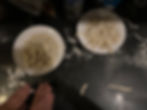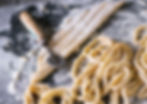
Flour, Eggs, and Friendship: How Pasta Nights Connect Us Everywhere
1
19
1
For the past four years, my life has been in constant motion. Between work, travel, and life’s unexpected turns, I’ve found myself living in different countries, meeting people from every corner of the world, and calling more than one place “home.” And yet, no matter where I land—whether it’s a small village in Malaysia, a flat in France, or, most recently, a cozy apartment in the Netherlands—one tradition always follows me: pasta night.
It’s not something I planned to turn into a ritual. It just… happened. The first time was a way to share a piece of home while living abroad; the next, it was a way to connect with strangers who would become friends. Over time, it became my way of grounding myself—rolling out fresh pasta with my hands, inviting people to gather around the table, filling the room with laughter, flour dust, and the promise of a good meal.



And the best part? Most people I meet have never made fresh pasta before. They arrive thinking it’s complicated or something only Italian nonnas can do, and leave surprised at how simple—and fun—it really is. We knead, roll, cut, and shape. Someone inevitably gets flour in their hair. Another person insists their pasta shape is “creative” rather than “wrong.” It all becomes a fun competition between the best gnocchetti shape.
But at the end, we sit together, proud of what we’ve made, eating something that tastes like so much more than just flour and eggs.
This Monday, a month into my stay in the Netherlands, I hosted my latest pasta night. The room was warm with conversation. Hands moved instinctively, even if for many it was the first time. Wine glasses clinked, sauce simmered slowly in the background, and I couldn’t help but think: this is why I keep doing it. Because in a world where we’re all rushing, it’s rare to spend a few hours creating something from scratch, side by side.

Pasta night isn’t just about dinner—it’s about connection.
From Kitchen Tables to Cultural Heritage
In Italy, making pasta by hand isn’t just a cooking skill—it’s a cultural inheritance. For generations, families have gathered around wooden kitchen tables to turn simple ingredients into something extraordinary. Flour is poured into a mound, a well is shaped in the center, eggs or water are added, and then the slow, rhythmic work begins. It’s a process that hasn’t changed much in centuries.
Historically, pasta-making was often a communal activity. In small towns, women would roll out sheets of dough together in courtyards, chatting about their day as they shaped orecchiette, tagliatelle, or tortellini.

Children would watch, learning the craft long before they were tall enough to reach the table without standing on a chair. The shapes and techniques varied from region to region—each form tied to the local climate, traditions, and ingredients available.

This tradition wasn’t just about feeding a family. It was a way to celebrate abundance, mark special occasions, and bring people closer. Fresh pasta was often prepared for weddings, Sunday lunches, or feast days, turning the meal into a shared event rather than just a necessity.
That’s the beauty of pasta-making—it’s as much about the hands you share it with as the food itself. The rolling pin becomes a conversation starter, the flour on your fingers a shared badge of honor, and the final plate a symbol of what you can create together. Even today, in modern kitchens far from Italy, those same values live on. Whether you’re in a farmhouse in Emilia-Romagna or a small city apartment in Amsterdam, the magic is the same: a table, a group of people, and dough waiting to be transformed.
A Practical Guide to Making Fresh Pasta Anywhere
You don’t need a professional kitchen or fancy tools to make pasta from scratch—just a flat surface, your hands, and a little patience. Here are three classic dough types that form the base of countless Italian pasta shapes.
Pasta all’Uovo (Egg Pasta)
Perfect for: tagliatelle, fettuccine, lasagna sheets, stuffed pasta (tortellini, ravioli)
Ingredients: 100 g (3.5 oz) all-purpose flour or “00” flour per egg (medium size)
Method:
Place the flour on a clean surface and make a well in the center.
Crack the eggs into the well.
Using a fork, gently beat the eggs, gradually incorporating the flour from the edges.
Knead for 8–10 minutes until smooth and elastic.
Wrap in plastic wrap and rest for at least 30 minutes before rolling out.
Then to shape it you can use either a pasta machine or a rolling-pin.
Tip: Resting the dough relaxes the gluten, making it easier to roll thin without springing back.

Pasta di Semola (Semolina Pasta)
Perfect for: orecchiette, cavatelli, busiate, trofie
Ingredients: 100 g (3.5 oz) semolina flour + ~50 ml (1.7 fl oz) warm water per person
Method:
Mix the semolina and water until it forms a rough dough.
Knead for 10 minutes until smooth and firm.
Wrap and let rest for at least 30 minutes.
Shape into your desired pasta form—often rolled into ropes and cut into small pieces for shaping.
Tip: Semolina dough is firmer than egg pasta, making it ideal for hand-shaped pasta that holds its texture when cooked.

Pasta all’Acqua (Water Pasta)
Perfect for: pici, lagane, and rustic styles from southern Italy
Ingredients: 100 g (3.5 oz) all-purpose flour per ~50 ml (1.7 fl oz) water
Method:
Combine flour and water until it forms a dough.
Knead for 8–10 minutes.
Rest for at least 20 minutes before rolling or shaping.
Tip: This is the simplest and most economical dough, historically popular in times of scarcity or for quick, everyday meals.

Why You Should Try It
Making pasta together is an instant icebreaker—it’s interactive, creative, and ends in a delicious reward. You learn something new, connect with people, and create memories you can taste. Whether you’re cooking with old friends or complete strangers, the simple act of mixing flour and water connects you across languages, backgrounds, and borders.
It’s proof that traditions can travel, adapt, and still keep their heart. You don’t need to be in Italy to taste its warmth—you just need a little flour, a little time, and people willing to share the experience. Because in the end, the pasta will be eaten, but the feeling of togetherness lasts far longer.

For me, pasta nights have become more than just cooking—they’re a way of carrying home with me, no matter where I am. From a tiny flat in France to a beachside hostel in Southeast Asia, and now in a small Dutch kitchen, the recipe is always the same: a table full of people, hands dusted with flour, laughter spilling over, and the comforting rhythm of dough being rolled and cut.
With Love
Maggy







I found this not only inspiring but also eye-opening especially for someone like me who used to think all pasta was just eggs and flour.
A dish that may seem simple but takes time and care doesn’t just bring people together; it makes you feel at home. Now I know exactly what I’m craving today and what I’ll be making at my next gathering.